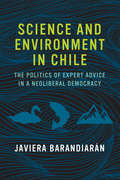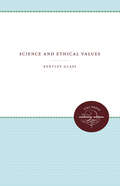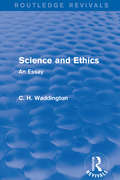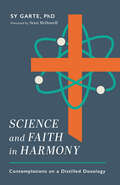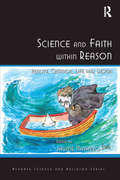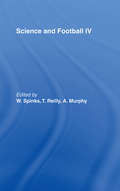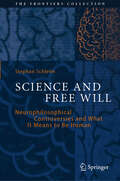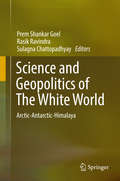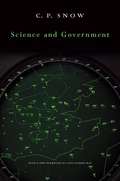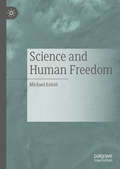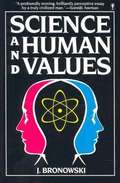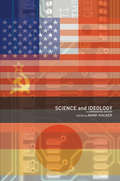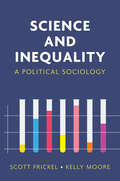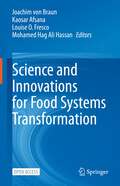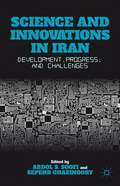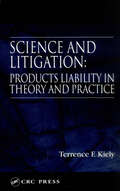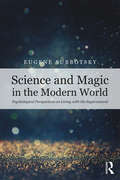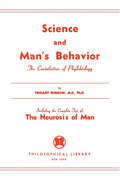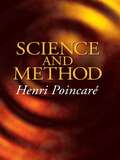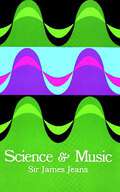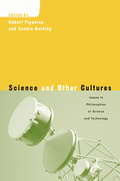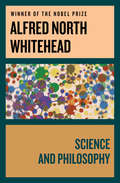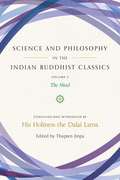- Table View
- List View
Science and Environment in Chile: The Politics of Expert Advice in a Neoliberal Democracy (Urban and Industrial Environments)
by Javiera BarandiaranThe politics of scientific advice across four environmental conflicts in Chile, when the state acted as a “neutral broker” rather than protecting the common good.In Science and Environment in Chile, Javiera Barandiarán examines the consequences for environmental governance when the state lacks the capacity to produce an authoritative body of knowledge. Focusing on the experience of Chile after it transitioned from dictatorship to democracy, she examines a series of environmental conflicts in which the state tried to act as a “neutral broker” rather than the protector of the common good. She argues that this shift in the role of the state—occurring in other countries as well—is driven in part by the political ideology of neoliberalism, which favors market mechanisms and private initiatives over the actions of state agencies. Chile has not invested in environmental science labs, state agencies with in-house capacities, or an ancillary network of trusted scientific advisers—despite the growing complexity of environmental problems and increasing popular demand for more active environmental stewardship. Unlike a high modernist “empire” state with the scientific and technical capacity to undertake large-scale projects, Chile's model has been that of an “umpire” state that purchases scientific advice from markets.After describing the evolution of Chilean regulatory and scientific institutions during the transition, Barandiarán describes four environmental crises that shook citizens' trust in government: the near-collapse of the farmed salmon industry when an epidemic killed millions of fish; pollution from a paper and pulp mill that killed off or forced out thousands of black-neck swans; a gold mine that threatened three glaciers; and five controversial mega-dams in Patagonia.
Science and Ethical Values (John Calvin McNair Lecture Series)
by Bentley GlassBentley Glass, one of the world's leading investigators in the field of human genetics, is concerned with the moral absolutes and ethics involved in experimentation with human life in the laboratory. He feels that with the development of knowledge must come wider recognition of consequences. His book indicates that we are responsible for all living things.Originally published in 1965.A UNC Press Enduring Edition -- UNC Press Enduring Editions use the latest in digital technology to make available again books from our distinguished backlist that were previously out of print. These editions are published unaltered from the original, and are presented in affordable paperback formats, bringing readers both historical and cultural value.
Science and Ethics: An Essay (Routledge Revivals: Selected Works of C. H. Waddington)
by C. H. WaddingtonFirst published in 1942 (second impression 1944), this book forms a debate about the endeavour to find an intellectual basis for ethics in science.
Science and Faith in Harmony: Contemplations on a Distilled Doxology
by Sy GarteRather than discord between science and Christian faith, there is a harmony as grand as any choral masterpiece The idea that Christianity and science are inextricably in conflict is a relatively recent conception. However, with each new scientific discovery and scriptural insight, it's an idea that's being proved to be insupportable. Sy Garte has immersed himself in both science and faith and knows they work beautifully together to sing of the greatness of God. Now this respected scientist shares how God's world (nature and science) and God's word (made flesh in Christ) are bound together in loving harmony. In Science and Faith in Harmony, Garte examines modern scientific concepts and what they can teach us about theological truths, such as the dual nature of Christ. He explores the ways in which the terminology and language of science and faith consistently match each other. Despite his deep dives into theology and science, Garte does not get overly technical in his writing. Instead, he is personal and passionate, speaking directly to readers with a tone of joy and wonder, inviting them to join the chorus of praise to the Lord. Readers still wondering whether the truths of science and Christian faith are in conflict need this book. Following the path of Christ and holding a scientific worldview at the same time is not only possible but also leads to a fuller, richer life of harmony and truth.
Science and Faith within Reason: Reality, Creation, Life and Design (Ashgate Science And Religion Ser.)
by Jaume NavarroScientists, historians, philosophers and theologians often engage in debates on the limitations and mutual interactions of their respective fields of study. Serious discussions are often overshadowed by the mass-produced popular and semi-popular literature on science and religion, as well as by the political agendas of many of the actors in these debates. For some, reducing religion and science to forms of social discourse is a possible way out from epistemological overlapping between them; yet is there room for religious faith only when science dissolves into one form of social discourse? The religion thus rescued would have neither rational legitimisation nor metaphysical validity, but if both scientific and religious theories try to make absolute claims on all possible aspects of reality then conflict between them seems almost inevitable. In this book leading authors in the field of science and religion, including William Carroll, Steve Fuller, Karl Giberson and Roger Trigg, highlight the oft-neglected and profound philosophical foundations that underlie some of the most frequent questions at the boundary between science and religion: the reality of knowledge, and the notions of creation, life and design. In tune with Mariano Artigas’s work, the authors emphasise that these are neither religious nor scientific but serious philosophical questions.
Science and Football IV
by W. Spinks T. Reilly A. MurphyThis edited collection brings together the latest research into the range of sports known as football.With contributions by a large number of the leading international researchers in the field, the book aims to bridge the gap between theory and practice in football, and to raise the awareness of the value of a scientific approach to the various football codes.The book contains nearly seventy papers, examining aspects ranging from match analysis and medical aspects of football to metabolism and nutrition, psychology and behaviour, and management and organization. Containing a wealth of research data, and a huge range of examples of how science can be applied; this book represents an invaluable reference for coaches, trainers, managers, medical staff, and all those involved in supporting performers in the many football codes.
Science and Free Will: Neurophilosophical Controversies and What It Means to Be Human (The Frontiers Collection)
by Stephan SchleimFree will is one of the most discussed topics in neuroscience, psychology and philosophy. Many even assume that our view of human nature and our social order are at stake. This book shows that the academic debate is often conducted under misleading assumptions: Practical freedom should not only be explored in quixotic laboratory experiments. Therefore, in the second part of Science and Free Will the problem is related to real decisions in our everyday lives. But first, important basic knowledge from over 2,500 years of our cultural history is conveyed. Learn how already Socrates rejected the idea that humans are only the sum of their physical parts. The book then shows how the dispute over free will in Christianity almost led to a civil war. From the 18th century onwards, scientifically influenced ideas became increasingly important. Biology, physiology and physics have an extensive say before psychology and brain research take over the topic. Science and Free Will explains why the endless debate over determinism is not the core of the problem. Well-known physicists such as Max Planck, Albert Einstein and Anton Zeilinger are discussed. The question is not whether our decisions are causally determined, but rather what causes play a role. What this means for the law, science and how we can still be free is discussed in detail at the end.
Science and Geopolitics of The White World
by Rasik Ravindra Prem Shankar Goel Sulagna ChattopadhyayThis book brings together thirteen selected papers presented in the Third International Seminar on Science and Geopolitics of Arctic-Antarctic-Himalaya, held in India in September 2015. The papers and have been grouped according to the Seminar's three main themes: a) Geopolitics of the Polar Regions, b) Global Climate Change and Polar Regions, and c) Climate Change and Himalayan Region.
Science and Government
by C. P. SnowScience and Government is a gripping account of one of the great scientific rivalries of the twentieth century. The antagonists are Sir Henry Tizard, a chemist from Imperial College, and Frederick Lindemann (Lord Cherwell), a physicist from the University of Oxford. The scientist-turned-novelist Charles Percy Snow tells a story of hatred and ambition at the top of British science, exposing how vital decisions were made in secret and sometimes with little regard to truth or the prevailing scientific consensus. Tizard, an adviser to a Labor government, believed the air war against Nazi Germany would be won by investing in the new science of radar. Lindemann favored bombing the homes of German citizens. Each man produced data to support his case, but in the end what mattered was politics. When Labor was in power, Tizard’s view prevailed. When the Conservatives returned, Lindemann, who was Winston Churchill’s personal adviser, became untouchable. Snow’s 1959 Two Cultures Rede Lecture propelled him to worldwide fame. Science and Government, originally the 1960 Godkin Lectures at Harvard, has been largely forgotten. Today the space occupied by scientists and politicians is much more contested than it was in Snow’s time, but there remains no better guide to it than Snow’s dramatic narrative.
Science and Human Experience
by Leon N CooperDoes science have limits? Where does order come from? Can we understand consciousness? Written by Nobel Laureate Leon N. Cooper, this book places pressing scientific questions in the broader context of how they relate to human experience. Widely considered to be a highly original thinker, Cooper has written and given talks on a large variety of subjects, ranging from the relationship between art and science, possible limits of science, to the relevance of the Turing test. These essays and talks have been brought together for the first time in this fascinating book, giving readers an opportunity to experience Cooper's unique perspective on a range of subjects. Tackling a diverse spectrum of topics, from the conflict of faith and science to whether understanding neural networks could lead to machines that think like humans, this book will captivate anyone interested in the interaction of science with society.
Science and Human Freedom
by Michael EsfeldThis book argues for two claims: firstly, determinism in science does not infringe upon human free will because it is descriptive, not prescriptive, and secondly, the very formulation, testing and justification of scientific theories presupposes human free will and thereby persons as ontologically primitive. The argument against predetermination is broadly Humean, or more precisely ‘Super-Humean’, whereas that against naturalist reduction is in large Kantian, drawing from Sellars on the scientific and the manifest image. Thus, whilst the book defends scientific realism against the confusion between fact and fake, it also reveals why scientific theories, laws and explanations cannot succeed in imposing norms for our actions upon us, neither on the level of the individual nor on that of society. Esfeld makes a strong case for an ontology of science that is minimally sufficient to explain our scientific and common sense knowledge, not only removing the concern that the laws of nature are incompatible with human freedom, but furthermore showing how our freedom is in fact a very presupposition for science.
Science and Human Values
by Jacob BronowskiThought-provoking essays on science as an integral part of the culture of our age from a leader in the scientific humanism movement. "A profoundly moving, brilliantly perceptive essay by a truly civilized man."--Scientific American.
Science and Ideology: A Comparative History (Routledge Studies in the History of Science, Technology and Medicine)
by Mark WalkerDoes science work best in a democracy? Were 'Soviet' or 'Nazi' science fundamentally different from science in the USA? These questions have been passionately debated in the recent past. Particular developments in science took place under particular political regimes, but they may or may not have been directly determined by them.Science and Ideology brings together a number of comparative case studies to examine the relationship between science and the dominant ideology of a state. Cybernetics in the USA is compared to France and the Soviet Union. Postwar Allied science policy in occupied Germany is juxtaposed to that in Japan. The essays are narrowly focussed, yet cover a wide range of countries and ideologies. The collection provides a unique comparative history of scientific policies and practices in the 20th century.
Science and Inequality: A Political Sociology
by Kelly Moore Scott FrickelScience and technology produce a wide range of benefits in society but they also create harm, both of which are unequally distributed across social groups and geographic regions. This incisive book provides a set of analytical tools to understand how inequality relating to science and technology is produced, and how the field can be reorganized to make good on its promise to improve life for all. Using a range of evidence and examples, Frickel and Moore show that science and technology are closely bound up with social inequalities, including linked problems of poor health, environmental degradation, racism, and sexism. They use the frame of “scientific inequality formations” to investigate the technoscientific sources of unequal power relations in society, examining issues such as the underdevelopment of non-profitable technologies, how laws and markets direct scientific advances, and the exclusion of certain social groups from the creation of knowledge and solutions relevant to their lives. This timely book illuminates interventions that redirect science and technology toward more equitable ends with the potential to be more widely distributed, charting a path to a more just future.
Science and Innovations for Food Systems Transformation
by Louise O. Fresco Joachim Von Braun Mohamed Hag Ali Hassan Kaosar AfsanaThis Open Access book compiles the findings of the Scientific Group of the United Nations Food Systems Summit 2021 and its research partners. The Scientific Group was an independent group of 28 food systems scientists from all over the world with a mandate from the Deputy Secretary-General of the United Nations. The chapters provide science- and research-based, state-of-the-art, solution-oriented knowledge and evidence to inform the transformation of contemporary food systems in order to achieve more sustainable, equitable and resilient systems.
Science and Innovations in Iran
by Abdol S. Soofi Sepehr GhazinooryOver the last two decades Iran has gone through major industrial transformation, in spite of major obstacles in the path of the country's development. This comprehensive book examines the Iranian government's mobilization of resources to develop science and technology, presenting an overview of the structure, dynamics, and outcomes of the government's science and technology policies. It evaluates sectors at the systems level and emphasizes the prominence of government, rather than of the market, in the innovation system of the Iranian economy. Written by authors who are in positions of leadership in the industries they discuss, this book offers an unparalleled look into Iran's current technology achievements.
Science and Litigation: Products Liability in Theory and Practice
by Terrence F. KielyThe question "what is science" has been one of the most vigorously contested legal questions as to what is legally acceptable scientific foundation for the submission of expert opinion in a wide variety of cases, especially in products liability cases. The answer usually lies in the outcomes of past cases as well as objective scientific literature.
Science and Magic in the Modern World: Psychological Perspectives on Living with the Supernatural
by Eugene V. SubbotskyScience and Magic in the Modern World is a unique text that explores the role of magical thinking in everyday life. It provides an excellent psychological look at the subconscious belief in magic in both popular culture and society, as well as experimental research that considers human consciousness as a derivative of belief in the supernatural, thus showing that our feelings, emotions, attitudes and other psychological processes follow the laws of magic. This book synthesises the science of ‘natural’ phenomena and the magic of the ‘supernatural’ to present an interesting look at the juxtaposition of the inner and outer selves. Fusing research into psychological disorders, subconscious feelings, as well as the rising presence of artificial intelligence, this book demonstrates how an engagement with magical thinking can enhance one’s creativity and cognitive skills. Science and Magic in the Modern World is an invaluable resource for those studying consciousness, as well as those looking at the effect of magical thinking on religion, politics, science and society.
Science and Man's Behavior
by Trigant BurrowEdited and compiled by William E. Galt after Burrow's death, Science and Man's Behavior: The Contribution of Phylobiology details the practices and therapies of one of the founding fathers of behavioral psychology. As a psychologist, Burrow was most interested in understanding and resolving man's behavioral conflict. He worked to shed light on behavioral disorders through his use of group- and phylo-therapy. Join Galt on a journey through Burrow's theories and practices in this important early text on a groundbreaking twentieth-century methodology. Trigiant Burrow was a founder of phylobiology and was a pioneer of using phyloanalysis as a therapy tool. Burrow was a trained doctor, biologist, and psychologist who specialized in experimental psychology. He studied psychoanalysis with Carl Jung and brought the European techniques to the United States. He studied and practiced experimental and behavioral psychology in Baltimore, Maryland for most of his life.
Science and Method
by Henri PoincaréThis classic by the famous mathematician defines the basic methodology and psychology of scientific discovery, particularly regarding mathematics and mathematical physics. Drawing on examples from many fields, it explains how scientists analyze and choose their working facts, and it explores the nature of experimentation, theory, and the mind. 1914 edition.
Science and Music (Dover Books On Music Ser.)
by James JeansSir James Jeans, noted British scientist, has given a physical analysis of musical sounds, in what is considered to be the best exposition on the subject, a book of great intellectual stature. His aim has been to convey precise information, in a simple non-technical way, that will be of interest to the amateur as well as the serious student of music. The discussion begins with an explanation of the development of the human faculty of hearing. It is established that each sound can be represented by a curve. An examination of the general properties of sound-curves follows. For example, why do some sounds produce pleasure when they reach our ears and some pain? How do we retain the pleasurable qualities in the sound-curve, as it passes on from one stage of electronic equipment to another? To what extent is it possible to prevent unpleasant qualities from contaminating the curve? These and other pertinent questions on the transmission and reproduction of sound-curves are answered in a discussion of tuning-forks and pure tones. The various methods of producing sound, and the qualities of the sounds produced, are further discussed as they relate to vibrations of strings and harmonics, and vibrations of air. Harmony and discord are also considered. In the final chapters on the concert room and hearing, the discussion focuses on the transmission of sound from its source to the eardrum and from the eardrum to the brain. A general theory of acoustics is also covered as well as acoustical analyses.
Science and Other Cultures: Issues in Philosophies of Science and Technology
by Sandra Harding Robert FigueroaFirst published in 2003. Routledge is an imprint of Taylor & Francis, an informa company.
Science and Philosophy
by Alfred North WhiteheadFrom a discussion of Einstein&’s theories to an analysis of meaning, the philosopher offers a fascinating collection of essays on a wide range of topics. This is a collection of many of Whitehead&’s papers that are scattered elsewhere. It was the penultimate book he published, and represents his mature thoughts on many topics. Philosophical Library has done a great service by publishing a representative collection of his writings on the subjects of Philosophy, Education and Science. The portion on Philosophy includes five papers: &“Immortality&”, &“Mathematics and the Good&”, &“Process and Reality&”, &“John Dewey and His Influence&” and the &“Analysis of Meaning.&” The first three chapters consist of Whitehead&’s personal reflections illumined by flashes of his lively humor. They are picturesque and amusing. The remainder of the book consists of chapters on Philosophy, Education, and Science. They cover in depth his positions on many scientific and philosophical matters in an extraordinarily unified way. The final section of the book is devoted to excellent surveys of Geometry and Mathematics as well as a paper on Einstein&’s theories.
Science and Philosophy in the Indian Buddhist Classics, Vol. 2: The Mind (Science and Philosophy in the Indian Bud #2)
by His Holiness the Dalai Lama John D. DunneThe second volume in a prominent new series on Buddhism and science, directed by the Dalai Lama and previously covered by the BBC.Science and Philosophy in the Indian Buddhist Classics compiles classical Buddhist explorations of the nature of our material world, the human mind, logic, and phenomenology and puts them into context for the modern reader. This ambitious four-volume series—a major resource for the history of ideas and especially the history of science and philosophy—has been conceived by and compiled under the visionary supervision of His Holiness the Dalai Lama himself. It is his view that the exploratory thinking of great Indian masters in the first millennium CE still has much that is of interest to us today, whether we are Buddhist or not. These volumes make those insights accessible. This, the second volume in the series, focuses on the science of the mind. Readers are first introduced to Buddhist conceptions of mind and consciousness and then led through traditional presentations of mental phenomena to reveal a Buddhist vision of the inner world with fascinating implications for the contemporary disciplines of cognitive science, psychology, emotion research, and philosophy of mind. Major topics include: -The distinction between sensory and conceptual processes and the pan-Indian notion of mental consciousness -Mental factors—specific mental states such as attention, mindfulness, and compassion—and how they relate to one another -The unique tantric theory of subtle levels of consciousness, their connection to the subtle energies, or &“winds,&” that flow through channels in the human body, and what happens to each when the body and mind dissolve at the time of death -The seven types of mental states and how they impact the process of perception -Styles of reasoning, which Buddhists understand as a valid avenue for acquiring sound knowledge In the final section, the volume offers what might be called Buddhist contemplative science, a presentation of the classical Buddhist understanding of the psychology behind meditation and other forms of mental training. To present these specific ideas and their rationale, the volume weaves together passages from the works of great Buddhist thinkers like Asanga, Vasubandhu, Nagarjuna, Dignaga, and Dharmakirti. His Holiness the Dalai Lama&’s introduction outlines scientific and philosophical thinking in the history of the Buddhist tradition. To provide additional context for Western readers, each of the six major topics is introduced with an essay by John D. Dunne, distinguished professor of Buddhist philosophy and contemplative practice at the University of Wisconsin. These essays connect the traditional material to contemporary debates and Western parallels, and provide helpful suggestions for further reading.
Science and Philosophy in the Indian Buddhist Classics: The Physical World
by Thupten Jinpa His Holiness the Dalai Lama Ian CoghlanExplore the nature of our material world in a unique sourcebook, conceived by the Dalai Lama, collecting the scientific observations found in classical Buddhist treatises. Under the visionary supervision of His Holiness the Dalai Lama, Science and Philosophy in the Indian Buddhist Classics brings together classical Buddhist explorations of the nature of our material world and the human mind and puts them into context for the modern reader. It is the Dalai Lama’s view that the explorations by the great masters of northern India in the first millennium CE still have much that is of interest today, whether we are Buddhist or not. Volume 1, The Physical World, explores of the nature of our material world—from the macroscopic to the microscopic. It begins with an overview of the many frameworks, such as the so-called five aggregates, that Buddhist thinkers have used to examine the nature and scope of reality. Topics include sources of knowledge, the scope of reason, the nature and constituents of the material world, theories of the atom, the nature of time, the formation of the universe, and the evolution of life, including a detailed explanation of the early Buddhist theories on fetal development. The volume even contains a brief presentation on early theories about the structure and function of the brain and the role of microorganisms inside the human body. The book weaves together passages from the works of great Buddhist thinkers like Asanga, Vasubandhu, Nagarjuna, Dignaga, and Dharmakirti. Each of the major topics is introduced by Thupten Jinpa, the Dalai Lama’s principal English-language translator and founder of the Institute of Tibetan Classics.
